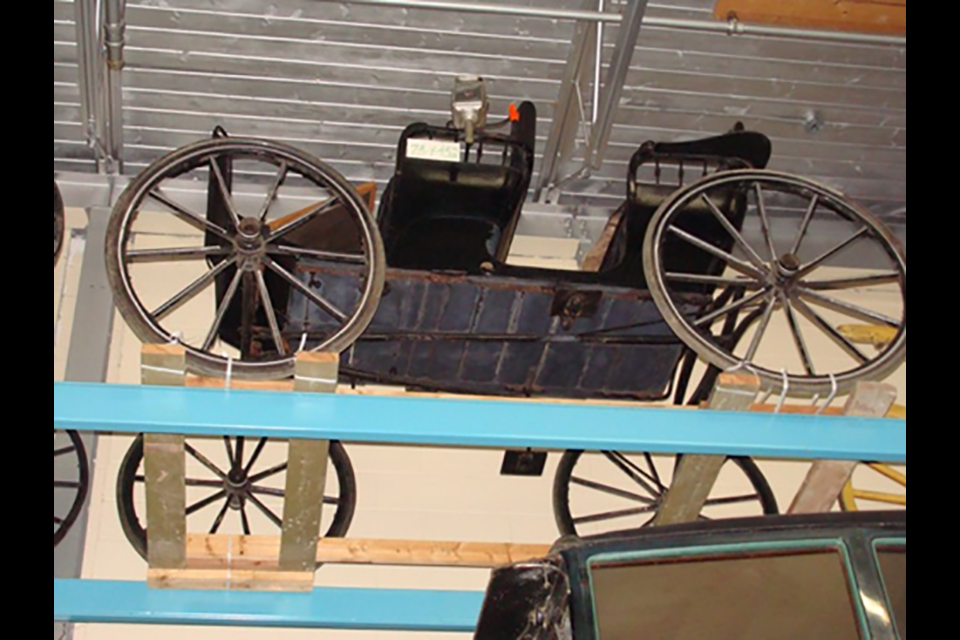VEREGIN- We’ve spent the past couple of weeks looking at the carriages, carts, and sleighs that Doukhobor leader Peter Vasil’evich (Lordly) Verigin once used, including one that is now part of the National Doukhobor Heritage Village’s collection.
Another carriage that survived the break-up of the Community in Veregin was a Democrat or Buckboard type manufactured by Deere & Co. in Winnipeg. Its description is:
• Body: black painted body with no top;
• Seats: two seats with tufted leather upholstery, both seat cushions removable, the front one covers a small storage compartment, the high rear seat back consists of an upholstered rectangular portion mounted above evenly spaced wood spindles or dowels which extend around sides of seats, flat curved leather armrests on either side of seat, and a leather flap along bottom edge of either seat;
• Headlamps: lanterns on either side of front seat have square-shaped bevel glass panel on front and right side and small round red glass in back with original silver-coloured finish painted over with silver-coloued paint;
• Wheels: four wheels, wheel circumference 98 inches (back), 94 inches (front), rubber rims stamped "John Bull - North Pole Patent - 8 x f-1 1/4 inch", with white striping on wooden wheel spokes and rims; and
• Misc: front dashboard; leather dash; metal arm rails, side dash rails and foot rails, with oval high footstep on either side of front and lower square one on either side in rear; whip holder on right side of dash; arched cylindrical steel axles with leaf suspension across either axle.
After the death of Peter V. Verigin in 1924, the Democrat was kept in the community implement shed at Veregin for several years. In 1933, then-Doukhobor leader Peter P. Verigin sold it to Independent Doukhobor Larion E. Konkin (1890-1974) of the Mikado district, who used it for day-to-day driving until 1945.
In 1949, Konkin donated the carriage to the WDM, formed the same year, where it was housed at the Saskatoon branch. It is unclear whether it was put on public display, although it may have been at one time. It was shown at some public events over the years, such as the commemoration of the 70th anniversary of the Doukhobors in Canada, held at Veregin in July 1969. Since 1984, it has been housed at the WDM storage facility in Saskatoon.
The carriage remains in overall good condition.
A third horse-drawn vehicle that survived the demise of the Community in Saskatchewan was a Gig or Chaise-style cart manufactured by the Canada Carriage Company in Brockville. Its description is as follows:
• Body: black painted body (no top) with red running gear, wheels and shafts;
• Seats: two seats with removable, rectangular, straw-stuffed cushions, upholstered in heavy, black, square-tufted leather with leather-covered buttons, sharing a common back comprised of a high, narrow, leather-covered, rectangular board mounted on two upright metal bars; leather flap along bottom edge of front seat; leather belt strap below rear seat has brass buckle; on either side of seat is an upright, curved, wooden side with metal rails at either end of each;
• Headlamps: headlamp on either side of front seat has brass rim, round bevel glass front, rectangular bevel glass side and small, round, red, glass opening in back;
• Wheels: two rubber rimmed wheels, with 190-inch circumference, shafts encased in leather on front third of either side; and
• Misc: front dashboard with metal railing; curved wooden floor board; metal foot rail and whip holder on right side of same; floor area open from dash to back end, the latter is a fold down, hinged end gate that hooks into an angle position to serve as a footboard for rear seat or opening to storage area below seat; high and low foot step on either side of front seat and one step on left side of back; steel axle; leaf spring across back end and side springs on either side.
Little information as to the provenance of the Gig is available, other than it was used by Peter V. Verigin, it likely came from the Veregin district, and that it was donated to the WDM in 1951. Since 1986, it has been housed at the WDM storage facility in Saskatoon.
The cart remains in overall good condition.
Carriages in British Columbia
It is worth noting that other carriages belonging to Peter V. Verigin have survived in British Columbia. A Barouche coach used by the Doukhobor leader in Nelson was donated to the Nelson Museum in 1957 and subsequently acquired by the Doukhobor Discovery Centre in Castlegar in 2010. It is in relatively weathered condition. Two others from Grand Forks – a Phaeton carriage and a Roadster buggy – were refurbished by the Boundary Woodworkers Guild in 2007 and loaned to the Boundary Museum & Archives in Grand Forks in 2013. They remain in good condition. A Bobsleigh from Grand Forks remains in a private family collection in original condition.
Conclusion
The surviving carriages, carts and sleighs of Peter V. (Lordly) Verigin represent a time gone by in Saskatchewan; a slower, simpler era when horse-power was essential for transport and travel. They also offer a unique window back in time in Doukhobor history and an opportunity to appreciate the quality and workmanship of the vehicles, their communal purpose, the strength and dependability of the horses that drew them, and the skill and horsemanship of their driver.
(Special thanks to Kaiti Hannah, Curatorial Associate, Western Development Museum; Phillip Perepelkin, Manager, National Doukhobor Heritage Village; Carter Hodgins, Canadian Transportation Museum & Heritage Village; John Stallard, Carriage Association of America.)
Don't count on social media to deliver your local news to you. Keep your news a touch away by bookmarking Canora Courier's homepage at this link.
Bookmark SASKTODAY.ca, Saskatchewan's home page, at this link.




